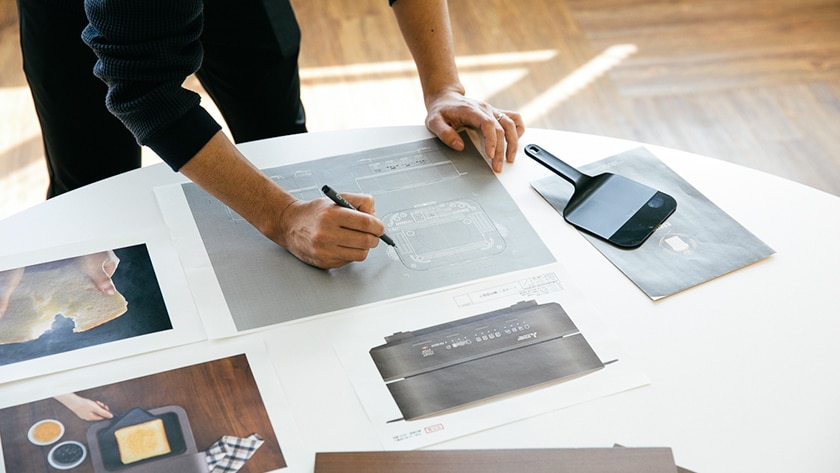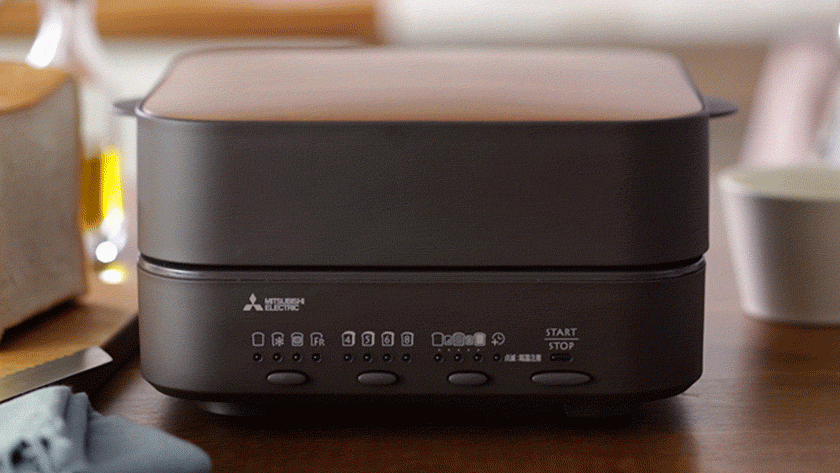All in the Details: Product Design with You in Mind
28th May, 2020

Mitsubishi Electric has garnered attention for its bread oven, a product that realizes bakery-fresh, toasted bread right at home. Now, it’s time to meet the two figures behind the oven’s conception: product designers Hiroaki Ito and Hitomi Yotsuya. The two delve into their respective approaches to product design, together with pondering future prospects for those in the craft: the physical products they make and the intangible experiences they provide.

User-Centered Design
To change society through product design – an ideal pursued by Hiroaki Ito and Hitomi Yotsuya, two product designers at Mitsubishi Electric’s Industrial Design Center. The pair share a fundamental approach to design, one that positions the user perspective as an element of vital importance. One of Yotsuya’s past projects serves as a testament to this: a cordless vacuum cleaner featuring air-purifying capabilities. The resulting product was revolutionary, one that turned preconceived notions of the vacuum cleaner on their head. Yotsuya’s concept marries functionality and design, serving to spark change and instill wonder in the modern lifestyle.
Devising this concept meant that Yotsuya had to step into the shoes of the consumer and tackle the challenges in front of her, and her creative solution is the result of that labor. She reflects: "The idea was to make a cordless stick-cleaner designed so as to blend seamlessly into the living room should it be left there by the user. We combine this design with the element of convenience: anyone can use the cleaner at the moment he or she feels inclined to, without any fuss. Up until now, people viewed vacuum cleaners as a device to be kept out of sight – hidden away in the recesses of a closet; vacuuming was a chore that many people hesitated to do. I realized that if we designed a cleaner that allowed a user to take it out without the typical fuss, we might be able to dispel the negative context surrounding the device altogether."
Ito shares this user-centered approach to design, and believes that there is vast potential to be discovered when implementing this philosophy for product development. Ito recalls vividly feeling this while designing an IH (induction heating) cooking heater geared specially for elderly customers.
"It all started because we wanted to make a product that a grandmother I was acquainted with, who has difficulties with her vision, could use. Throughout the development and design process, the user experience of the elderly individual was kept constantly in mind and was a deciding factor in narrowing down functionality, color, and other aspects," Ito reflects. "I gave her the heater after we were finished with it, and she wrote us this wonderful thank-you letter in Braille. All members of the staff were moved by it; the product gave us the conviction that even household appliances could be of even greater help to others than we realized."

Two Designers, One Oven
Yotsuya and Ito – two designers gifted with ingenuity and a spirit of enterprise. The two joined forces in creating a revolutionary new bread oven – one that could toast bread to a soft texture and mellow taste on a par with bakery-fresh flavors. The project saw its beginnings in 2015 at an in-house "ideathon" at Mitsubishi Electric, at a time that bread consumption had just begun to overshadow rice as a central staple of the Japanese diet, Yotsuya recalls. This change in the times presented an unparalleled opportunity, sparking an idea for a bread oven that could toast a slice of bread with care, that would change how Japan experiences breakfast – and become the new face of the Japanese dining table.
The designers began development through a process of trial and error, tinkering with designs in hopes of getting closer to their ideal flavor. But they soon drastically shifted their approach, and the project took a pivotal turn when designers applied the sealed structure often seen in rice cookers to the oven. Low and behold, the resulting flavor was a caliber above what they had tasted before. This simple application represented a turning point for the project; designers training their sights on a new goal – realizing warm, bakery-fresh bread at home.
Now the winner of multiple awards such as the Good Design Award, this bread oven is known not only for its functionality but also for its compact size, small enough to fit on the dining table. Yotsuya expands on this point.
"We made sure to create the oven compact enough to sit on the dining table. Imagining how busy mornings can be – we wanted people to be able to make their own perfect toast at the table without having to fuss about in the kitchen. Another thing was that ‘toast with toppings’ was something you saw a lot on social media at the time, and we wanted our oven to allow people to do the same thing in their homes. Hence a design that allows one to open the lid from the top."
Yotsuya’s words reveal her keen awareness and willingness to understand the user experience. Ito seems to feel a sense of accomplishment at what they’ve accomplished: "We’re beginning to see this ‘bread-oven lifestyle’ starting to take root with our users."

Changing Society with Design
One could say that consumption trends are shifting as of late; there seems to be less focus on objects in themselves and more on the experiences they provide. Consumers place less emphasis on purchasing items like luxury brands and expensive cars. Instead, Mitsubishi Electric sees them shifting to intangible things to be experienced; life-changing vacations, or lessons to improve their skills, for example.
But Yotsuya and Ito seek to create products while maintaining a firm gaze on the physical item itself. In doing so, they believe product design can bring further change to the incorporeal, intangible realm of experience – enriching people’s lifestyles and sparking change in society at large as a result.
Yotsuya elaborates: "My hope is to design products that help consumers as they work to attain their ideal lifestyles. Lifestyle in Japan in particular is ripe with challenges, with the issues of our expanding aging population and decreased in the birth rate being among them. I think our design center has the ability to not only change a person’s life through a product, but also bring changes to the world at large through social projects. The arenas where we can contribute in that regard are only continuing to grow."
Ito echoes this sentiment: "I also view design as a vehicle to help others, and for me personally I hope to use it to help the elderly. At the same time, I want to try working in a project that works to change society on a grand scale. Mitsubishi Electric has been around for a century now, and throughout our history, we have adapted to the tides of the times and have overcome numerous situations and challenges. I consider it another mission of mine to make sure that this legacy, or "DNA," carries on uninterrupted into future generations."
Ito and Yotsuya – two product designers and creators of hit commodities. One cannot help but wonder about what’s on the horizon for them, and look forward to what they’ll create next.
(This article was originally published on April 16, 2020.)
The content is true and accurate as of the time of publication.Information related to products and services included in this article may differ by country or region.
